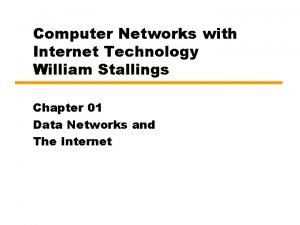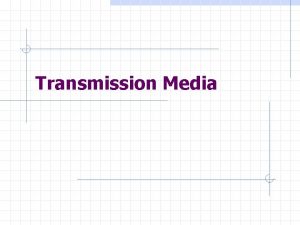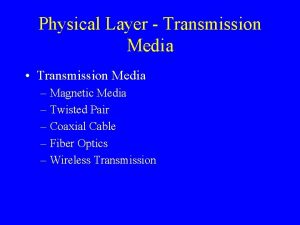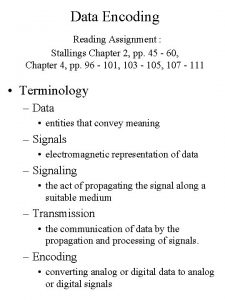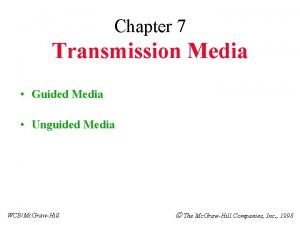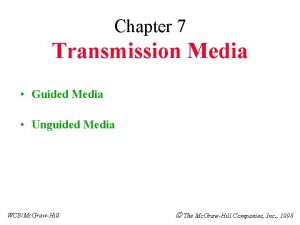Transmission Media Reading Assignment Stallings Chapter 3 Transmission











- Slides: 11

Transmission Media Reading Assignment : Stallings Chapter 3 • Transmission Media – physical path between transmitter and receiver – electromagnetic wave – Guided transmission • solid medium, copper twisted pair, coaxial cable, optical fiber • data rate mainly determined by medium – Unguided transmission • atmosphere, outer space • wireless transmission • low frequencies : omnidirectional (all directions)

• high frequencies : possible to focus signal • transmission characteristics determined by bandwidth – Factors determining data rate and distance • bandwidth – greater bandwidth : higher data rate • transmission impairments – attenuation » twisted pair > coaxial cable > optical fiber • interference – by unshielded cables – from competing signals in overlapping frequency bands • number of receivers – Each attachment introduces some attenuation and distortion on the line.

• Guided transmission media – point-to-point vs. multipoint – Twisted pair • Physical description – least expensive, most widely used – Spiral pattern decreases crosstalk interference. – Neighboring pairs have different twist length (2 - 6 in). – bundled together in hundreds – limitation : data rate and distance • Applications – analog » telephone systems » private branch exchange (PBX) » end office (of phone company) – digital » digital switch or digital PBX (64 kbps) » local area network : 10 Mbps or 100 Mbps (limited length) » long distance (4 Mbps)

• Transmission characteristics – amplifiers needed » analog signals : 5 - 6 km » digital signals : 2 - 3 km – high attenuation for higher frequency – susceptible to interference and noise » shielding to reduce interference from power lines » twisting to reduce low-frequency interference » different twist lengths – point-to-point analog signals » bandwidth ~ 250 k Hz : a few voice channels – long distance point-to-point digital signals » ~ 4 Mbps – short distance digital signals » ~ 100 Mbps • Unshielded twisted pair (UTP) – Category 3 and 5 UTP • Shielded twisted pair (STP)

– Coaxial cable • Physical description • Applications – TV distribution (cable TV) – long distance telephone transmission » inferior to optical fibre – short-run computer system links » high speed I/O – local area networks (LAN) • Transmission characteristics – much better than twisted pair in attenuation, thermal noise, and intermodulation noise – analog signals : amplifiers every few km – digital signals : repeaters every km – Optical fiber • Physical description – core » thin strand of fibre of glass or plastic – cladding » glass or plastic – jacket

• Advantages over twisted pair or coaxial cable – – greater capacity smaller size, lighter weight lower attenuation electromagnetic isolation » no radiation of energy, little interference to others, difficult to tap - security – greater repeater spacing • Applications – long-haul trunks » 900 miles, 20 k - 60 k voice channels » replacing coaxial cables in telephone networks – metropolitan trunks » joining telephone exchanges in a metropolitan area » average 7. 8 miles, 100 k voice channels – rural-exchange trunks – subscriber loops » from central exchange to a subscriber » still more expensive than twisted pair – local area networks » 100 Mbps, 100 - 1000 stations in a building complex

• Transmission characteristics – multimode : variety of reflecting angles – single mode : a single angle can pass -- the axial ray – light source » light-emitting diode (LED) : cheaper, longer operational life, greater temperature range » injection laser diode (ILD) : more expensive, higher data rates – wavelength windows » 850, 1300, 1550 nm, all infrared • Wireless transmission – antenna • directional transmission – focused electromagnetic beam, higher frequency • omnidirectional transmission

– Frequencies • broadcast radio – VHF, part of UHF • microwave – part of UHF, all of SHF – 2 G Hz ~ 40 G Hz » directional, point-to-point – 30 M Hz ~ 1 G Hz » omnidirectional, broadcast • infrared – 3 X 1011 ~ 2 X 1014 Hz – point-to-point, confined areas – Terrestrial microwave • Physical description – parabolic dish, 10 ft in diameter, installed high above ground, rigidly fixed, focused on next receiving antenna / relay tower » e. g. , 100 m high => 82 km apart • Applications – long-haul telecommunications service » requiring line-of-sight transmission » voice and TV

– short point-to-point links between buildings – private short-haul microwave link to bypass local telephone company – also used to propagate cable TV to local installations, and then to subscribers via coaxial cable • Transmission characteristics – Attenuation varies as the square of the distance. » For twisted pair and coaxial cable, loss varies logarithmically with distance. » I. e, repeaters or amplifiers are farther apart for microwave systems. – Attenuation increases with frequency. – Attenuation increases with rainfall. – Assignment of frequency bands is strictly regulated to avoid interference. – Higher frequency => higher potential bandwidth => higher data rate » for short distance » smaller and cheaper antenna

– Satellite microwave • Physical description – satellite = microwave relay station » earth / ground station » uplink frequency band downlink frequency band » transponder channels / transponders » point-to-point and broadcast » geostatic satelites : height 35, 784 km, period of rotation = earth’s period » 4 angular spacing with respect to earth for 4/6 G Hz band, 3 for 12/14 G Hz band. • Applications – TV distribution » direct broadcast satellite (DBS) : video signal directly to home user – long-distance telephone transmission » point-to-point trunks between exchange offices – private business networks » Divide total capacity into a number of leased channels to individual business users. » Very small aperture terminal (VSAT) : a low cost private network

• Transmission characteristics – 1 - 10 G Hz » below 1 G Hz : galactic, solar, atmospheric noise » above 10 G Hz : atmospheric attenuation – typical frequency : 4 / 6 G Hz band » uplink : 5. 925 - 6. 425 G Hz » downlink : 3. 7 - 4. 2 G Hz – propagation delay : about 0. 25 sec from one ground station to another – inherently broadcast nature
 While reading activities
While reading activities Garbage collection stallings
Garbage collection stallings Stallings garbage pickup
Stallings garbage pickup William stallings network security essentials 5th edition
William stallings network security essentials 5th edition Network security essentials william stallings ppt
Network security essentials william stallings ppt William stallings computer networks
William stallings computer networks Daphne metamorphoses
Daphne metamorphoses Computer organization and architecture william stallings
Computer organization and architecture william stallings Metodo stallings
Metodo stallings William stallings
William stallings William stallings
William stallings Simplified data communication model
Simplified data communication model





